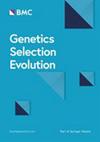瘤胃宏基因组图谱是可遗传的,新西兰国家羊群的肠道甲烷排放量排名
IF 3.1
1区 农林科学
Q1 AGRICULTURE, DAIRY & ANIMAL SCIENCE
引用次数: 0
摘要
减少温室气体排放以履行国际气候变化承诺的全球目标促使畜牧业制定解决方案,在保持生产的同时减少反刍动物的甲烷排放。研究表明,利用基因组选择对低甲烷排放的反刍动物进行选择性育种是实现国家层面甲烷排放目标的一个可行解决方案。然而,这需要在全国范围内对单个动物进行足够的甲烷测量。在羊身上,一种可负担得起的测量农场甲烷的方法是便携式积累室(PAC),它可以根据动物的甲烷排放量对其进行排名,尽管这种方法并非没有挑战。另一种选择是使用一种与PAC甲烷测量基因相关的代理性状。其中一个已经显示出希望的特征是瘤胃宏基因组群落(RMC)谱。在这项研究中,我们利用来自新西兰几个羊群和年份的4585只混合性别羔羊的大型羊数据集,研究了使用RMC剖面作为PAC甲烷排放代理性状的潜力。使用限制性内切酶还原测序,在PAC测量后立即收集动物的瘤胃样本,生成RMC谱。我们预测了甲烷(CH4)和二氧化碳(CO2)排放量(克/天),以及CH4/(CO2 + CH4)的比率(CH4Ratio),从RMC谱和snp阵列基因型数据。所有性状的遗传率和微生物率估计值与文献中发现的值相似。与宿主基因组学相比,RMC谱的PAC甲烷与预测甲烷的相关性为1.9- 2.3倍(CH4)和1.2- 1.5倍(CH4比率)。当使用由数据集中最近出生年份的动物组成的验证集时,RMC剖面预测的甲烷与PAC甲烷之间的CH4遗传相关性为0.75±0.12,CH4Ratio为0.64±0.11。RMC剖面与PAC甲烷测量具有预测性和遗传相关性。因此,RMC谱是确定动物甲烷排放遗传优势的一个合适的替代性状,可以纳入现有的育种计划,以促进低甲烷排放羊的选择性育种。本文章由计算机程序翻译,如有差异,请以英文原文为准。
Rumen metagenome profiles are heritable and rank the New Zealand national sheep flock for enteric methane emissions
Global targets to reduce greenhouse gas emissions to meet international climate change commitments have driven the livestock industry to develop solutions to reduce methane emission in ruminants while maintaining production. Research has shown that selective breeding for low methane emitting ruminants using genomic selection is one viable solution to meet methane targets at a national level. However, this requires obtaining sufficient measures of methane on individual animals across the national herd. In sheep, one affordable method for measuring methane on-farm to rank animals on their methane emissions is portable accumulation chambers (PAC), although this method is not without its challenges. An alternative is to use a proxy trait that is genetically correlated with PAC methane measures. One such trait that has shown promise is rumen metagenome community (RMC) profiles. In this study, we investigate the potential of using RMC profiles as a proxy trait for methane emissions from PAC using a large sheep dataset consisting of 4585 mixed-sex lambs from several flocks and years across New Zealand. RMC profiles were generated from rumen samples collected on the animals immediately after being measured through PAC using restriction enzyme-reduced representation sequencing. We predicted methane (CH4) and carbon dioxide (CO2) emissions (grams per day), as well as the ratio CH4/(CO2 + CH4) (CH4Ratio), from the RMC profiles and SNP-array genotype data. Heritability and microbiability estimates were similar to values found in the literature for all traits. The correlation of PAC methane with predicted methane was 1.9- to 2.3-fold (CH4) and 1.2- to 1.5-fold (CH4Ratio) greater for RMC profiles compared to host genomics only. The genetic correlation between methane predicted from RMC profiles and PAC methane was 0.75 ± 0.12 for CH4 and 0.64 ± 0.11 for CH4Ratio when using a validation set consisting of the animals with the most recent year of birth in the dataset. RMC profiles are predictive of, and genetically correlated, with PAC methane measures. Therefore, RMC profiles are a suitable proxy trait for determining the genetic merit of an animal’s methane emissions and could be incorporated into existing breeding programs to facilitate selective breeding for low methane emitting sheep.
求助全文
通过发布文献求助,成功后即可免费获取论文全文。
去求助
来源期刊

Genetics Selection Evolution
生物-奶制品与动物科学
CiteScore
6.50
自引率
9.80%
发文量
74
审稿时长
1 months
期刊介绍:
Genetics Selection Evolution invites basic, applied and methodological content that will aid the current understanding and the utilization of genetic variability in domestic animal species. Although the focus is on domestic animal species, research on other species is invited if it contributes to the understanding of the use of genetic variability in domestic animals. Genetics Selection Evolution publishes results from all levels of study, from the gene to the quantitative trait, from the individual to the population, the breed or the species. Contributions concerning both the biological approach, from molecular genetics to quantitative genetics, as well as the mathematical approach, from population genetics to statistics, are welcome. Specific areas of interest include but are not limited to: gene and QTL identification, mapping and characterization, analysis of new phenotypes, high-throughput SNP data analysis, functional genomics, cytogenetics, genetic diversity of populations and breeds, genetic evaluation, applied and experimental selection, genomic selection, selection efficiency, and statistical methodology for the genetic analysis of phenotypes with quantitative and mixed inheritance.
 求助内容:
求助内容: 应助结果提醒方式:
应助结果提醒方式:


